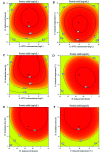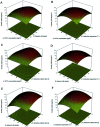Optimization of bacterial cytokine protein production by response surface methodology for environmental bioremediation
- PMID: 35492803
- PMCID: PMC9043431
- DOI: 10.1039/d1ra03565g
Optimization of bacterial cytokine protein production by response surface methodology for environmental bioremediation
Abstract
In natural and engineered systems, most microorganisms would enter a state of dormancy termed as "viable but non-culturable" (VBNC) state when they are exposed to unpredictable environmental stress. One of the major advances in resuscitating from such a state is the discovery of a kind of bacterial cytokine protein called resuscitation-promoting factor (Rpf), which is secreted from Micrococcus luteus. In this study, the optimization of Rpf production was investigated by the response surface methodology (RSM). Results showed that an empirical quadratic model well predicted the Rpf yield, and the highest Rpf protein yield could be obtained at the optimal conditions of 59.56 mg L-1 IPTG, cell density 0.69, induction temperature 20.82 °C and culture time 7.72 h. Importantly, Phyre2 web portal characterized the structure of the Rpf domain to have a shared homology with lysozymes, and the highest lysozyme activity was at pH 5 and 50 °C. This study broadens the knowledge of Rpf production and provided potential strategies to apply Rpf as a bioactivator for environmental bioremediation.
This journal is © The Royal Society of Chemistry.
Conflict of interest statement
There are no conflicts to declare.
Figures






Similar articles
-
Unveiling the distribution characteristics of rpf-like genes and indigenous resuscitation promoting factor production in PCB-contaminated soils.J Environ Manage. 2024 Apr;357:120803. doi: 10.1016/j.jenvman.2024.120803. Epub 2024 Apr 3. J Environ Manage. 2024. PMID: 38569268
-
Optimization of protein production by Micrococcus luteus for exploring pollutant-degrading uncultured bacteria.Springerplus. 2014 Feb 28;3:117. doi: 10.1186/2193-1801-3-117. eCollection 2014. Springerplus. 2014. PMID: 24616844 Free PMC article.
-
Evaluation of Rpf protein of Micrococcus luteus for cultivation of soil actinobacteria.Syst Appl Microbiol. 2021 Sep;44(5):126234. doi: 10.1016/j.syapm.2021.126234. Epub 2021 Jul 17. Syst Appl Microbiol. 2021. PMID: 34343788
-
Exploring the potential environmental functions of viable but non-culturable bacteria.World J Microbiol Biotechnol. 2013 Dec;29(12):2213-8. doi: 10.1007/s11274-013-1390-5. Epub 2013 Jun 4. World J Microbiol Biotechnol. 2013. PMID: 23733177 Review.
-
Current Perspectives on Viable but Non-Culturable (VBNC) Pathogenic Bacteria.Front Public Health. 2014 Jul 31;2:103. doi: 10.3389/fpubh.2014.00103. eCollection 2014. Front Public Health. 2014. PMID: 25133139 Free PMC article. Review.
Cited by
-
Optimizing recombinant production of L-asparaginase 1 from Saccharomyces cerevisiae using response surface methodology.Folia Microbiol (Praha). 2024 Dec;69(6):1205-1219. doi: 10.1007/s12223-024-01163-2. Epub 2024 Apr 6. Folia Microbiol (Praha). 2024. PMID: 38581537
-
Probiotic and postbiotic analytical methods: a perspective of available enumeration techniques.Front Microbiol. 2023 Dec 7;14:1304621. doi: 10.3389/fmicb.2023.1304621. eCollection 2023. Front Microbiol. 2023. PMID: 38192285 Free PMC article. Review.
-
Resuscitation-Promoting Factor Accelerates Enrichment of Highly Active Tetrachloroethene/Polychlorinated Biphenyl-Dechlorinating Cultures.Appl Environ Microbiol. 2023 Jan 31;89(1):e0195122. doi: 10.1128/aem.01951-22. Epub 2023 Jan 11. Appl Environ Microbiol. 2023. PMID: 36629425 Free PMC article.
References
-
- Ma R. Yan X. Mi X. Wu Y. Qian J. Zhang Q. Chen G.-H. Chem. Eng. J. 2021;425:131457. doi: 10.1016/j.cej.2021.131457. - DOI
LinkOut - more resources
Full Text Sources
Molecular Biology Databases

